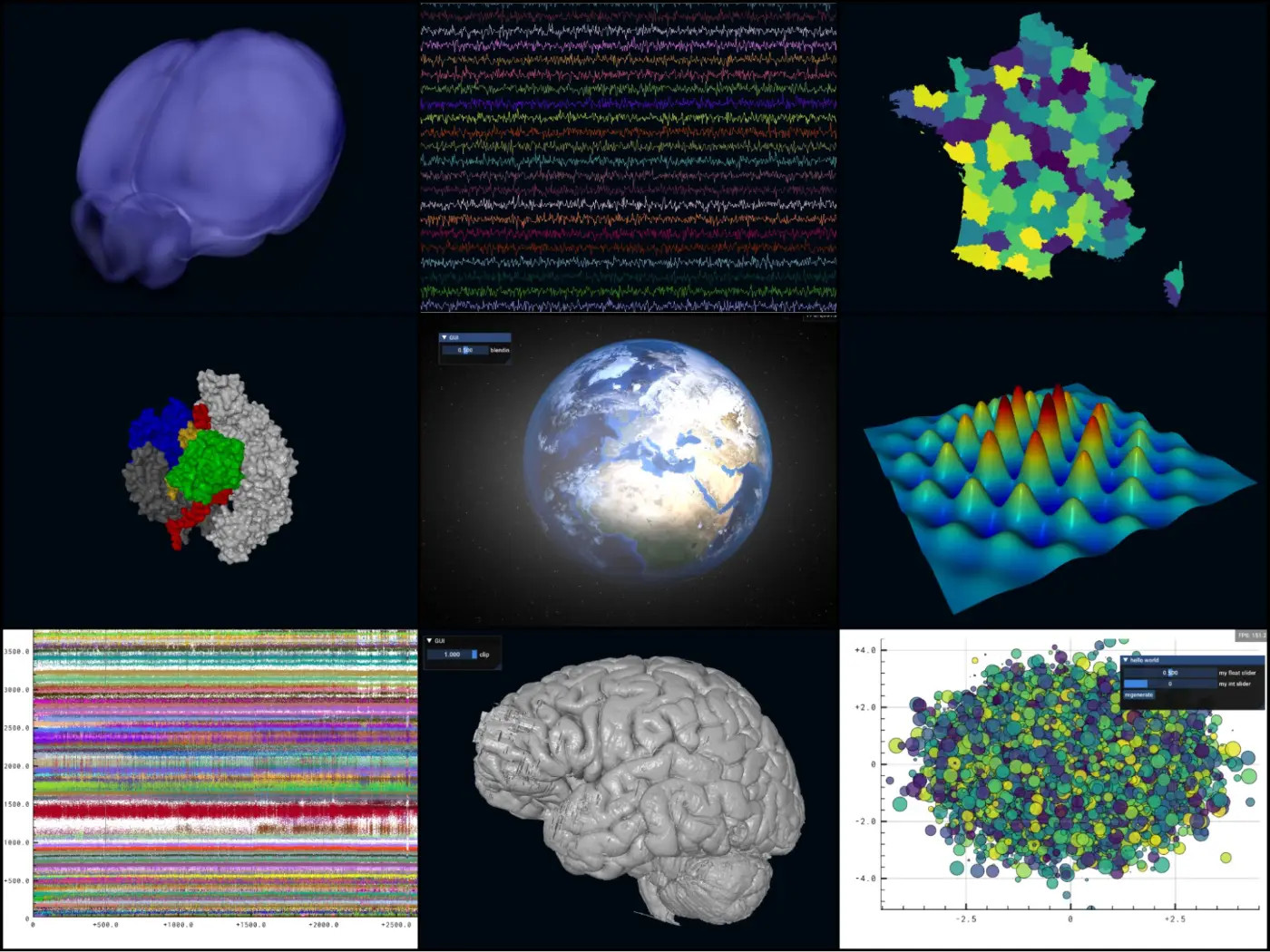

Datoviz: Ultra-Fast, High-Performance GPU Scientific Visualization Library Built on Vulkan
Highlights:
- High-performance scientific visualization: Datoviz leverages Vulkan to achieve exceptional rendering speeds, handling millions of data points efficiently while maintaining high visual quality and interactivity.
- Cross-platform reliability and scalability: Vulkan ensures consistent performance across different GPU vendors and operating systems, making Datoviz a reliable solution for scientific visualization on Windows, Linux, and macOS.
- Future-proof and developer-friendly: Datoviz’s integration with Vulkan allows for future extensions such as other graphics APIs while providing a thin Vulkan wrapper, vklite, making it easier for scientific users to harness GPU power without extensive Vulkan expertise.
Overview
Datoviz is a cross-platform, open-source, high-performance GPU scientific data visualization library designed for interactive exploration of large datasets. Written in C/C++, it leverages the Khronos Vulkan® graphics API and integrates with the glfw window library. Datoviz aims to provide a unified, language-agnostic platform for interactive visualization in both 2D and 3D, with support for GUIs and general-purpose GPU compute.
The library provides raw ctypes bindings in Python and is positioned to serve as the primary GPU backend for VisPy 2.0, a Chan Zuckerberg Initiative (CZI)-funded scientific visualization project. Datoviz brings performance, portability, and scalability to scientific 2D/3D visualization applications, allowing graphical exploration of large amounts of data.
Datoviz is developed primarily by its principal author, who has dedicated extensive effort to optimizing the library for performance, visual quality, and scalability. The project is also supported by Nicolas Rougier from Inria Bordeaux, France, with a focus on developing a backend-agnostic graphical protocol for scientific visualization.
Problem Statement:
The scientific community increasingly relies on large datasets—often in the gigabyte to terabyte range—across disciplines such as biomedical imaging, neuroscience, astronomy, chemistry, and engineering. Traditional visualization methods struggle to efficiently render these massive datasets interactively while maintaining high visual fidelity. OpenGL, a common choice in scientific computing, imposes limitations that hinder performance when handling large numbers of visual primitives.
For effective scientific exploration, researchers require a library that can:
- Efficiently render millions of visual primitives, such as points, markers, lines, images, and volumetric data.
- Support smooth interactivity for panning, zooming, rotating, and data selection.
- Maintain high-quality rendering, including proper antialiasing for 2D visuals.
- Offer a streamlined API for scientific users who lack GPU programming expertise.
The Solution: How Vulkan Improves Modern Scientific Visualization
Vulkan, a low-level, cross-platform graphics API from the Khronos Group, provides the control and efficiency necessary for high-performance scientific visualization. Vulkan enables explicit control over GPU resources, leading to more predictable and optimized performance. By leveraging Vulkan, Datoviz achieves:
- Fine-grained resource management: Vulkan’s explicit memory management allows Datoviz to optimize GPU utilization, avoiding the bottlenecks common in OpenGL-based implementations.
- Scalable rendering of large datasets: Vulkan’s command buffers and parallel processing capabilities enable efficient rendering of millions of points and other primitives without performance degradation.
- Improved visual quality: Datoviz implements advanced antialiasing techniques, a critical feature for 2D scientific visualization that is often challenging to execute correctly on the GPU.
- Backend flexibility: With its thin Vulkan wrapper, vklite, Datoviz provides a more accessible yet still powerful API, making it easier for developers to integrate Vulkan without excessive boilerplate code.
"Vulkan has provided Datoviz with exceptional performance and portability, allowing us to efficiently handle massive datasets across multiple platforms. Vulkan offers predictable and reliable performance, making it an ideal choice for scientific visualization. The ability to explicitly manage GPU resources has significantly improved our rendering pipeline, leading to faster data processing and higher-quality visualization results,” said Cyrille Rossant, Neuroscience researcher and software engineer at IBL (International Brain Laboratory) and UCL (University College London).
Benefits of Using Vulkan
- Unmatched performance:
- Vulkan’s efficient rendering pipeline allows Datoviz to achieve thousands of frames per second (FPS) with large datasets.
- Explicit control over GPU synchronization minimizes overhead, leading to smooth and responsive interaction.
- Cross-platform consistency:
- Unlike OpenGL, Vulkan exhibits fewer inconsistencies across different GPU vendors, ensuring reliable performance across Windows, Linux, and macOS (via MoltenVK).
- Optimized for scientific use cases:
- Datoviz leverages Vulkan’s features to efficiently handle static but data-intensive scenes, which are common in scientific visualization.
- The explicit API design allows researchers to fine-tune their visualizations based on specific dataset requirements.
- Future-proofing and flexibility:
- Vulkan’s low-level control makes it easier to decouple rendering logic from the underlying graphics API, enabling future integrations with other graphics APIs.
- The vklite wrapper provides a simpler Vulkan API for scientific users who may not have extensive GPU programming expertise.
Conclusion
Vulkan is not just for video games—it is a powerful tool for scientific visualization, enabling researchers to interact with complex datasets at unprecedented speeds. Datoviz demonstrates how Vulkan’s capabilities can be leveraged for high-performance GPU visualization, tackling the challenges of large-scale scientific data rendering while maintaining flexibility and efficiency.
By implementing a robust Vulkan-based rendering engine, Datoviz sets a new standard for interactive scientific visualization. It allows researchers to explore, analyze, and present massive datasets with precision, ensuring that the power of modern GPUs is fully harnessed for scientific discovery.